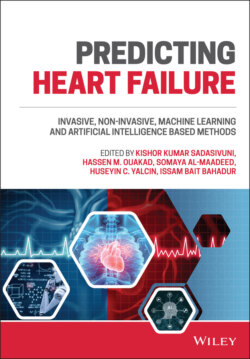Читать книгу Predicting Heart Failure - Группа авторов - Страница 74
2.4.3 Echocardiogram (Ultrasound Devices)
ОглавлениеEchocardiogram devices were first introduced in 1950, when the first M-mode echocardiography was developed by two physicists in order to study mitral stenosis and its diagnosis. Their work inspired many cardiologists, as they carried out their work to develop Doppler, two-dimensional (2D), contrast, and transesophageal echocardiograms. The echocardiogram was inspired by stethoscopes, and actually enables users to observe what occurs underneath the human skin [19]. The general setup of the echocardiography method is given in Figure 2.7.
Figure 2.7 The echocardiography method. The patient lies in the left lateral decubitus position, and the ultrasound probe generates sound waves, receives an echo from body tissues, and sends the results to the ultrasound processing unit/computer to create a sonogram image.
The echocardiogram is an ultrasound of the heart that provides moving pictures capable of identifying the structure and function of the heart. It is more effective and efficient than ECG for detecting heart disease. ECG mainly provides information on the rhythm of the heart and involves a lengthy procedure compared to the an echocardiogram which involves a quick test that can be done in 5 minutes. An echocardiogram helps to visualize the heart beating and pumping blood, and aids the identification of heart disease. Providing information about heart functioning by measuring heart rate and rhythm, ECG is the preliminary test for detecting heart problems; any abnormality found here demands further diagnostic tests like an echocardiogram. Moreover, defects in heart valves are often undetected by ECG and the echocardiogram is the more preferred method for detecting valvular heart diseases. The echocardiogram is more efficient, but expensive compared to ECG.
